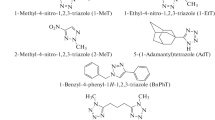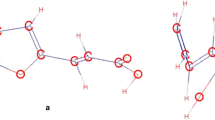Abstract
The temperature dependences of vapour pressures for some mono- and di-halogenated anisoles were established using the transpiration method. The solution calorimetry-based approach was used to determine the vaporization/sublimation enthalpies of chlorine- and iodine-substituted anisoles. The enthalpies of fusion of 2,3-di-chloro-anisole and 4-iodo-anisole were measured using differential scanning calorimetry. The literature thermochemical data for halogen-substituted anisoles (with halogen = F, Cl, Br, and I) and new results were evaluated using “structure–property” correlations and quantum-chemical calculations. The G* quantum chemical methods were validated for reliable estimation of the enthalpies of formation of substituted for halogen-substituted anisoles in the gaseous state. The evaluated thermodynamic data were used for designing the “centrepiece” method for assessment of enthalpies of vaporization and enthalpies of formation for halogen-substituted anisoles.
Graphical abstract

Similar content being viewed by others
References
Verevkin SP, Andreeva IV, Emel’yanenko VN. Thermodynamic framework for the predicting the properties of amino-benzoic acids. J Chem Thermodyn. 2022. https://doi.org/10.1016/j.jct.2021.106689.
Andreeva IV, Verevkin SP. Thermochemistry of substituted benzenes: acetophenones with methyl, ethyl, cyano and acetoxy substituents. J Therm Anal Calorim. 2022. https://doi.org/10.1007/s10973-022-11326-3.
Verevkin SP, Samarov AA, Riabchunova AV. Interactions between substituents in the benzene ring. Experimental and theoretical study of Methoxy substituted acetophenones. SSRN. 2022. https://doi.org/10.2139/ssrn.4075458.
Verevkin SP, Konnova ME, Turovtsev VV, Riabchunova AV, Pimerzin AA. Weaving a network of reliable thermochemistry around lignin building blocks: Methoxy-Phenols and Methoxy-Benzaldehydes. Ind Eng Chem Res. 2020. https://doi.org/10.1021/acs.iecr.0c04281.
Nagrimanov RN, Samatov AA, Solomonov BN. Additive scheme of solvation enthalpy for linear, cyclic and branched-chain aliphatic compounds at 298.15 K. J Mol Liq. 2019. https://doi.org/10.1016/j.molliq.2019.111365.
Solomonov BN, Varfolomeev MA, Nagrimanov RN, Novikov VB, Buzyurov AV, Fedorova YV, et al. New method for determination of vaporization and sublimation enthalpy of aromatic compounds at 298.15K using solution calorimetry technique and group-additivity scheme. Thermochim Acta. 2015. https://doi.org/10.1016/j.tca.2015.09.022.
Solomonov BN, Varfolomeev MA, Nagrimanov RN, Novikov VB, Zaitsau DH, Verevkin SP. Solution calorimetry as a complementary tool for the determination of enthalpies of vaporization and sublimation of low volatile compounds at 298.15 K. Thermochim Acta. 2014. https://doi.org/10.1016/j.tca.2014.05.033.
Basařová P, Svoboda V. Calculation of heats of vaporization of halogenated hydrocarbons from saturated vapour pressure data. Fluid Phase Equilibr. 1991. https://doi.org/10.1016/0378-3812(91)85008-I.
Spieksma W, Luijk R, Govers HAJ. Determination of the liquid vapour pressure of low-volatility compounds from the Kováts retention index. J Chromatogr A. 1994. https://doi.org/10.1016/0021-9673(94)80602-0.
Ribeiro da Silva MAV, Lobo Ferreira AIMC. Gas phase enthalpies of formation of monobromophenols. J Chem Thermodyn. 2009; https://doi.org/10.1016/j.jct.2009.04.017.
Almeida ARRP, Monte MJS. Crystalline and liquid vapour pressures of the four p-monohalophenols: a thermodynamic study of their phase transitions. J Chem Thermodyn. 2013. https://doi.org/10.1016/j.jct.2013.05.047.
Ribeiro da Silva MAV, Lobo Ferreira AIMC. Thermochemical study of four isomers of dichloroanisole. J Chem Thermodyn. 2008; https://doi.org/10.1016/j.jct.2008.02.003.
Verevkin SP, Emel’yanenko VN. Transpiration method: Vapor pressures and enthalpies of vaporization of some low-boiling esters. Fluid Phase Equilibr. 2008. https://doi.org/10.1016/j.fluid.2008.02.001.
Nagrimanov RN, Samatov AA, Buzyurov AV, Kurshev AG, Ziganshin MA, Zaitsau DH, et al. Thermochemical properties of mono- and di-cyano-aromatic compounds at 298.15 K. Thermochim Acta. 2018. https://doi.org/10.1016/j.tca.2018.07.026.
Zaitseva KV, Varfolomeev MA, Novikov VB, Solomonov BN. Enthalpy of cooperative hydrogen bonding in complexes of tertiary amines with aliphatic alcohols: calorimetric study. J Chem Thermodyn. 2011. https://doi.org/10.1016/j.jct.2011.02.019.
Zaitseva KV, Varfolomeev MA, Solomonov BN. Thermodynamic functions of hydrogen bonding of amines in methanol derived from solution calorimetry data and headspace analysis. Thermochim Acta. 2012. https://doi.org/10.1016/j.tca.2012.02.005.
Emel’yanenko VN, Nagrimanov RN, Solomonov BN, Verevkin SP. Adamantanes: Benchmarking of thermochemical properties. J Chem Thermodyn. 2016. https://doi.org/10.1016/j.jct.2016.05.017.
Ziganshin MA, Bikmukhametova AA, Gerasimov AV, Gorbatchuk VV, Ziganshina SA, Bukharaev AA. The effect of substrate and air humidity on morphology of films of L-leucyl-L-leucine dipeptide. Prot Met Phys Chem. 2014. https://doi.org/10.1134/s2070205114010171.
Curtiss LA, Redfern PC, Raghavachari K, Rassolov V, Pople JA. Gaussian-3 theory using reduced Mo/ller-Plesset order. J Chem Phys. 1999. https://doi.org/10.1063/1.478385.
Curtiss LA, Redfern PC, Raghavachari K. Gaussian-4 theory. J Chem Phys. 2007. https://doi.org/10.1063/1.2436888.
Frisch MJ, Trucks GW, Schlegel HB, Scuseria GE, Robb MA, Cheeseman JR et al. Gaussian 16, Revision C.01 Gaussian, Inc., Wallingford CT, 2016.
Stull DR. Vapor pressure of pure substances. Organic and inorganic compounds. Ind Eng Chem. 1947. https://doi.org/10.1021/ie50448a022.
Dreisbach RR, Shrader SA. Vapor pressure-temperature data on some organic compounds. Ind Eng Chem. 1949. https://doi.org/10.1021/ie50480a054.
Stephenson RM, Malanowski S. Handbook of the thermodynamics of organic compounds. Dordrecht: Springer; 1987.
Emel’yanenko VN, Verevkin SP. Benchmark thermodynamic properties of 1,3-propanediol: comprehensive experimental and theoretical study. J Chem Thermodyn. 2015. https://doi.org/10.1016/j.jct.2015.01.014.
Verevkin SP, Sazonova AY, Emel’yanenko VN, Zaitsau DH, Varfolomeev MA, Solomonov BN, et al. Thermochemistry of halogen-substituted methylbenzenes. J Chem Eng Data. 2015. https://doi.org/10.1021/je500784s.
Chickos JS, Hosseini S, Hesse DG, Liebman JF. Heat capacity corrections to a standard state: a comparison of new and some literature methods for organic liquids and solids. Struct Chem. 1993. https://doi.org/10.1007/BF00673701.
Acree W, Chickos JS. Phase transition enthalpy measurements of organic and organometallic compounds. sublimation, vaporization and fusion enthalpies from 1880 to 2015. Part 1. C1−C10. J Phys Chem Ref Data. 2016; https://doi.org/10.1063/1.4948363.
Brennan D, Ubbelohde AR. A thermochemical evaluation of bond strengths in some carbon compounds. Part IV. Bond-strength differences based on the reaction: RI + HI → RH + I2, where R =p-methoxyphenyl and cyclohexyl. J Chem Soc (Resumed). 1956; https://doi.org/10.1039/JR9560003011.
Ribeiro da Silva MAV, Lobo Ferreira AIMC. Experimental and computational study on the molecular energetics of the three monofluoroanisole isomers. J. Chem Thermodyn. 2009; https://doi.org/10.1016/j.jct.2008.09.012.
Hasty D, Drapekin J, Subramanian T, Winter TC, Chickos JS, Samarov AA, et al. Applications of correlation gas chromatography and transpiration studies for the evaluation of the vaporization and sublimation enthalpies of some perfluorinated hydrocarbons. J Chem Eng Data. 2012. https://doi.org/10.1021/je300504f.
Ribeiro da Silva MAV, Ferreira AIMCL. Standard molar enthalpies of formation of the three isomers of chloroanisole. J Chem Thermodyn. 2008; https://doi.org/10.1016/j.jct.2007.10.001.
Ribeiro da Silva MAV, Lobo Ferreira AIMCL. Experimental and computational study on the molecular energetics of monobromoanisole isomers. J Chem Thermodyn. 2009; https://doi.org/10.1016/j.jct.2008.11.008.
Lobo Ferreira AIMC, Ribeiro da Silva MAV. Experimental and computational study of the molecular energetics of the monoiodoanisole isomers. J Chem Thermodyn. 2012;4 https://doi.org/10.1016/j.jct.2011.12.001.
Almeida ARRP, Pinheiro BDA, Lima CFRAC, Santos AFLOM, Ferreira ACS, Almeida Paz FA et al. Thermodynamic Properties of Moldy-Musty Contaminants of Wine. J Chem Eng Data. 2019; https://doi.org/10.1021/acs.jced.9b00062.
Solomonov BN, Varfolomeev MA, Nagrimanov RN, Novikov VB, Zaitsau DH, Verevkin SP. Solution calorimetry as a complementary tool for the determination of enthalpies of vaporization and sublimation of low volatile compounds at 298.15K. Thermochim Acta. 2014. https://doi.org/10.1016/j.tca.2014.05.033.
Zherikova KV, Verevkin SP. Ferrocene: temperature adjustments of sublimation and vaporization enthalpies. Fluid Phase Equilibr. 2018. https://doi.org/10.1016/j.fluid.2018.05.004.
Zaitsau DH, Pimerzin AA, Verevkin SP. Fatty acids methyl esters: Complementary measurements and comprehensive analysis of vaporization thermodynamics. J Chem Thermodyn. 2019. https://doi.org/10.1016/j.jct.2019.01.007.
Mintz C, Gibbs J, Acree WE, Abraham MH. Enthalpy of solvation correlations for organic solutes and gases dissolved in acetonitrile and acetone. Thermochim Acta. 2009. https://doi.org/10.1016/j.tca.2008.11.015.
Klamt A, Jonas V, Bürger T, Lohrenz JCW. Refinement and Parametrization of COSMO-RS. J Phys Chem A. 1998. https://doi.org/10.1021/jp980017s.
Abdelaziz A, Zaitsau DH, Kuratieva NV, Verevkin SP, Schick C. Melting of nucleobases. Getting the cutting edge of “Walden’s Rule.” Phys Chem Chem Phys. 2019. https://doi.org/10.1039/C9CP00716D.
Kováts E. Gas-chromatographische Charakterisierung organischer Verbindungen. Teil 1: Retentionsindices aliphatischer Halogenide, Alkohole, Aldehyde und Ketone. HCA. 1958; https://doi.org/10.1002/hlca.19580410703.
Verevkin SP. Vapour pressures and enthalpies of vaporization of a series of the linear n-alkyl-benzenes. J Chem Thermodyn. 2006. https://doi.org/10.1016/j.jct.2005.11.009.
Korhonen IOO. Gas—liquid chromatographic analyses: XXVIII. Capillary column studies of chlorinated anisoles. J Chromatogr A. 1984. https://doi.org/10.1016/S0021-9673(01)96118-7.
Führer U, Deißler A, Schreitmüller J, Ballschmiter K. Analysis of halogenated methoxybenzenes and hexachlorobenzene (HCB) in the picogram m−3 range in marine air. Chromatogr. 1997. https://doi.org/10.1007/BF02505594.
Pfeifer O, Lohmann U, Ballschmiter K. Halogenated methyl-phenyl ethers (anisoles) in the environment: determination of vapor pressures, aqueous solubilities, Henry's law constants, and gas/water- (Kgw), n-octanol/water- (Kow) and gas/n-octanol (Kgo) partition coefficients. J Anal Chem. 2001. https://doi.org/10.1007/s002160101077.
Gautzsch R, Zinn P. Use of incremental models to estimate the retention indexes of aromatic compounds. Chromatogr. 1996. https://doi.org/10.1007/BF02292946.
Jalali-Heravi M, Garkani-Nejad Z. Prediction of gas chromatographic retention indices of some benzene derivatives. J Chromatogr A. 1993. https://doi.org/10.1016/0021-9673(93)80421-4.
Haken JK, Vernon F. Gas chromatography of halogenated derivatives of cyclohexane, benzene and anisole. J Chromatogr A. 1986. https://doi.org/10.1016/S0021-9673(01)86893-X.
Chickos JS, Hosseini S, Hesse DG. Determination of vaporization enthalpies of simple organic molecules by correlations of changes in gas chromatographic net retention times. Thermochim Acta. 1995. https://doi.org/10.1016/0040-6031(95)90670-3.
Verevkin SP, Heintz A. Determination of vaporization enthalpies of the branched esters from correlation gas chromatography and transpiration methods. J Chem Eng Data. 1999. https://doi.org/10.1021/je990122a.
Korol AN, Novorusskaya NV. Selectivity of stationary phases for some polar benzene derivatives. J Chromatogr A. 1979. https://doi.org/10.1016/0021-9673(75)85033-3.
Kawaki H. Solute-stationary phase interaction in gas liquid chromatography. Thermodynamic parameters for substituted halogenobenzene derivatives. Chem Pharm Bull. 2001. https://doi.org/10.1248/cpb.49.5.
Trouton F. IV. On molecular latent heat. Lond Edinburgh Dublin Philos Mag J Sci. 1884; https://doi.org/10.1080/14786448408627563.
Emel’yanenko VN, Zaitseva KV, Agapito F, Martinho Simões JA, Verevkin SP. Benchmark thermodynamic properties of methylanisoles: experimental and theoretical study. J Chem Thermodyn. 2015. https://doi.org/10.1016/j.jct.2015.02.001.
Dorofeeva OV, Vishnevskiy YV, Rykov AN, Karasev NM, Moiseeva NF, Vilkov LV, et al. Molecular structure, conformation, potential to internal rotation, and ideal gas thermodynamic properties of 3-fluoroanisole and 3,5-difluoroanisole as studied by gas-phase electron diffraction and quantum chemical calculations. J Mol Struct. 2006. https://doi.org/10.1016/j.molstruc.2005.12.035.
Pracht P, Bohle F, Grimme S. Automated exploration of the low-energy chemical space with fast quantum chemical methods. Phys Chem Chem Phys. 2020. https://doi.org/10.1039/C9CP06869D.
Petersson GA, Bennett A, Tensfeldt TG, Al-Laham MA, Shirley WA, Mantzaris J. A complete basis set model chemistry. I. The total energies of closed-shell atoms and hydrides of the first-row elements. J Cheml Phys. 1988. https://doi.org/10.1063/1.455064.
Roux MV, Temprado M, Chickos JS, Nagano Y. Critically evaluated thermochemical properties of polycyclic aromatic hydrocarbons. J Phys Chem Ref Data. 2008. https://doi.org/10.1063/1.2955570.
Verevkin SP, Emel’yanenko VN, Varfolomeev MA, Solomonov BN, Zherikova KV, Melkhanova SV. Thermochemistry of Dihalogen-substituted benzenes: data evaluation using experimental and quantum chemical methods. J Phys Chem B. 2014. https://doi.org/10.1021/jp5097844.
Acknowledgements
This paper has been supported by the Kazan Federal University Strategic Academic Leadership Program (‘PRIORITY-2030’).
Author information
Authors and Affiliations
Contributions
RNN: Conceptualization, Methodology, Writing—Original draft preparation, Supervision. ARI: Writing—original draft, Investigation. ARI: Writing—original draft, Investigation. DAK: Writing—original draft, Investigation. MAZ: Writing—original draft, Investigation. BNS: Methodology. SPV: Conceptualization, Methodology, Writing—Original draft preparation, Supervision.
Corresponding authors
Ethics declarations
Conflict of interest
The authors declare no competing financial interest.
Additional information
Publisher's Note
Springer Nature remains neutral with regard to jurisdictional claims in published maps and institutional affiliations.
Supplementary Information
Below is the link to the electronic supplementary material.
Rights and permissions
Springer Nature or its licensor holds exclusive rights to this article under a publishing agreement with the author(s) or other rightsholder(s); author self-archiving of the accepted manuscript version of this article is solely governed by the terms of such publishing agreement and applicable law.
About this article
Cite this article
Nagrimanov, R.N., Ibragimova, A.R., Italmasov, A.R. et al. Energetics of substituent effects on the benzene ring: CH3O with F, Cl, Br, and I. J Therm Anal Calorim 148, 1087–1108 (2023). https://doi.org/10.1007/s10973-022-11673-1
Received:
Accepted:
Published:
Issue Date:
DOI: https://doi.org/10.1007/s10973-022-11673-1




